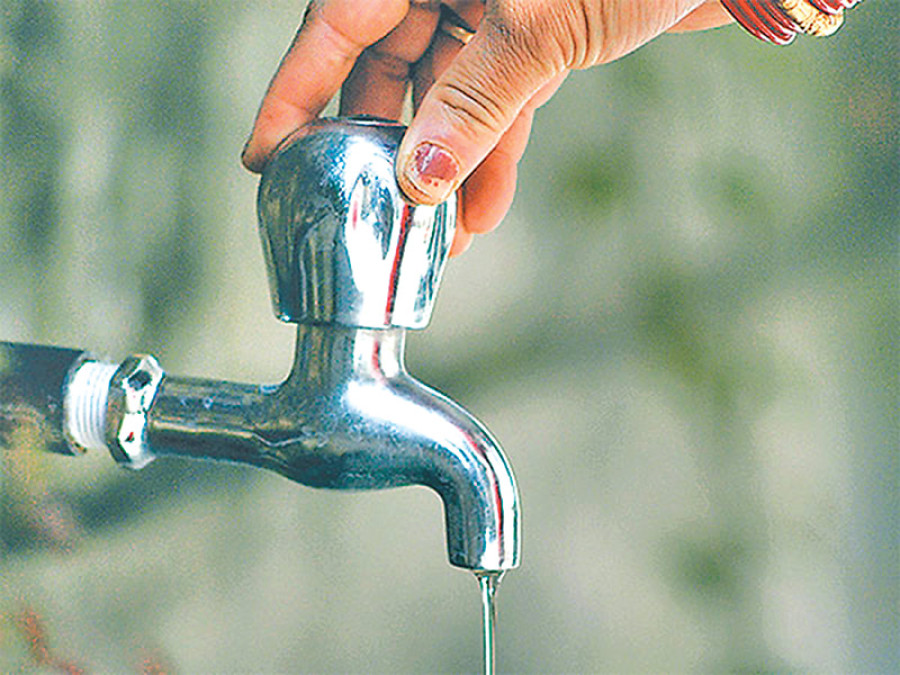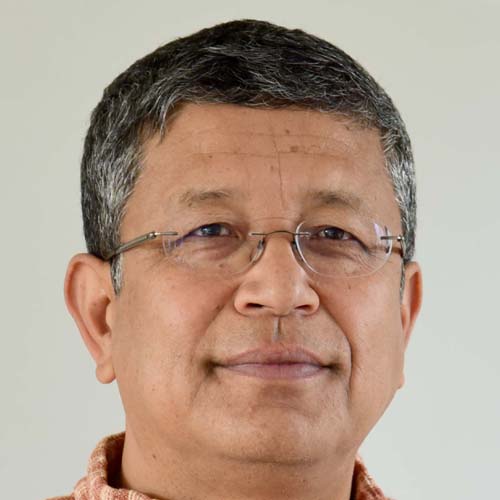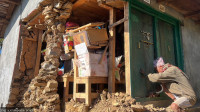Opinion
All dried up
With the monsoons finally upon us, most residents of the capital can now take it easy owing to the reprieve the bountiful rains will provide from the bane of perennial water shortages in Kathmandu.
Deepak Thapa
With the monsoons finally upon us, most residents of the capital can now take it easy owing to the reprieve the bountiful rains will provide from the bane of perennial water shortages in Kathmandu. While parts of the valley will have no choice but to continue to rely on tankers, it will not be so bad for the lucky rest. Unfortunately, news has recently come that the long-awaited and much-delayed Melamchi Water Supply Project is not going to flush through our water systems by the earlier planned date of October. Come autumn, water is once again going to be at a premium until the Melamchi system kicks in at a date that is anybody’s guess at the moment.
No quick-fix
Writing in Himal magazine a quarter century ago, water resources engineer, Ajaya Dixit described the Melamchi project as ‘nothing more than a child’s grasping for a lollipop held out by an indulgent international banker’. One can have quibbles with that characterisation but surely not with his subsequent observation that the project is not ‘a product of responsible planning for the Valley’s, or the country’s future. Rather than being the result of a long-term, rigorous planning process, it is a quick-fix response to Kathmandu Valley’s perceived water supply problems.’
Despite all the ballyhoo about it (remember the late Krishna Prasad Bhattarai’s election campaign promise to wash Kathmandu’s streets with water from Melamchi), the project is hardly going to solve our water woes. When completed, the project will be able to supply only 170 million of the Valley’s daily requirement of 370 million litres. The current system provides 110 million litres, of which an estimated 30 to 40 percent is lost through leakage from the antiquated supply network. Even presuming that all of the 170 million litres from Melamchi reaches the intended destinations, there will still be a shortfall of around at least 100 million litres. Of course, plans are already afoot to bring in a further 340 million litres of water by expanding the Melamchi project’s intake watershed. Going by the pace at which the project has proceeded thus far, we can rest assured that is a long way off. Kathmandu is going to remain semi-parched until then.
Had our planners been serious about solving Kathmandu’s water shortage, they could have undertaken any number of steps to save as well as augment the available supply of water. For starters, even simple steps such as mandating the maximum volume of toilet cisterns sold in Nepal could save scores of litres in a single residence every day. It is a common enough practice around the world where there is presumably more enlightened policy-making. For instance, in the United Kingdom no cistern above six litres’ capacity is allowed to be installed. That was a figure reached gradually with reductions from the 13-litre caverns in the 1960s down to 11 litres to 9.5 to 7.5, and finally, to the 6-litre limit that has been in place since 2001. Nepal has no such law in place, and the local market sells cisterns of all shapes and sizes, most of which contribute to unnecessarily flushing extra litres of clean and potable water down the drain.
Another way to save water is to make it mandatory for all cisterns sold to have clearly marked dual-flush systems. As everyone with experience using a flush toilet knows, flushing urine in the commode with all the contents of the cistern is a sheer waste of water; this is something that can easily be accomplished by just a ‘half-flush’. That is why water-poor countries such as Australia, Singapore and Israel have legislated the compulsory installation of dual-flush cisterns.
Having such laws in place could have potentially led to fewer dozens of litres of water per capita every day. Multiply that by the millions of bathroom trips and that represents a lot of water saved for wider redistribution. And, unlike in countries mentioned above where existing toilets had to be retrofitted in keeping with new regulations, since Nepal has been experiencing a construction boom for years, even that expense could have been spared had we mandated all new buildings to use water-efficient flush systems.
Running dry
The ongoing rapid urbanisation of Kathmandu Valley and the rising expanse of built-up areas should also have been a matter of concern for our planners. For a Valley that used to be filled with agricultural land which allowed rainwater to seep into the soil and provide much of its water needs through natural springs and wells, the gradual covering up of the same land with impenetrable surfaces has meant that much more water is being wasted as run-off.
In a research paper published a couple of years ago, Ashim Ratna Bajracharya, Ritu Raj Rai and Shreema Rana estimated that compared to 1996, by 2008, an excess of 25 billion litres of rainwater was flowing unchecked into the rivers of the Valley every year. They reached this conclusion by comparing the built-up landscape between 1996 and 2008, which saw such areas double in size, from 1545 to 3057 hectares in the intervening period. Ten years later, the situation is definitely much worse and whole communities are now realising that their underground sources are either running dry or the water table has receded much deeper.
Yet, apart from perfunctory gestures, there has been no proactive attempt to conserve even a small part of the 1500 mm of rain Kathmandu receives annually. The one initiative to introduce compulsory rainwater harvesting systems in new buildings in Kathmandu has not been heard of for years. Simple solutions such as ensuring every building has a recharge pit to allow rainwater to move underground rather than into the sewer system would have been sufficient to replenish the water table continuously. The danger of over-extraction of groundwater has been painfully evident in Mexico City, where land subsidence has turned the terrain in hitherto-flat neighbourhoods into undulating surfaces. Like Kathmandu, Mexico City, too, lies on the bed of a dried-out lake, something that should be of great concern to us as well.
The lollipop
Considering the amount of time it has taken Melamchi to be built, paradoxically, ‘quick-fix’ might not be the appropriate descriptor for the project even if the principle behind the descriptor remains accurate, since it undercuts all attempts to find other equally tenable, complementary and sustainable solutions. Our water mandarins instead remain fixated on multi-million dollar projects for obvious reasons. And, the political class finds any number of reasons to go along. At the most mundane level is the fact that it allows them access to project vehicles, which by definition generally means fancy SUVs. To cite one news report from 2009, among the grandees who had appropriated vehicles from the Melamchi Water Supply Project for personal use were two former Prime Ministers as well as the then Minister for Physical Planning and Works (with another vehicle set aside for his cronies). From the news report, it was clear that the bureaucracy, too, was complicit in taking advantage of their official positions, with two government secretaries, two former Executive Directors of the Melamchi Water Supply Project, and the chairman of the Water Supply Tariff Fixation Commission also having taken off with project vehicles.
With such perks readily available, solutions proposed above, such as enforcing cistern capacity or encouraging rainwater harvesting, stand nary a chance of being adopted. I guess the reference to lollipop certainly rings true here.




 8.12°C Kathmandu
8.12°C Kathmandu










